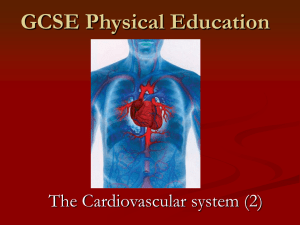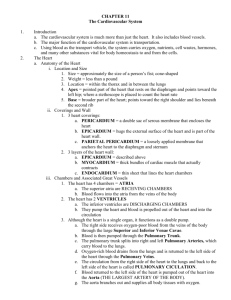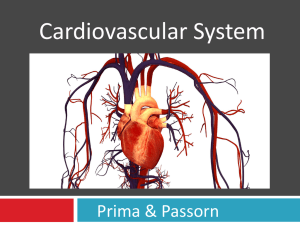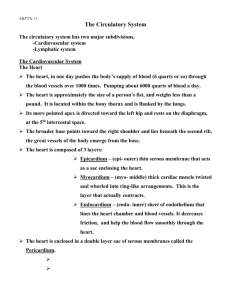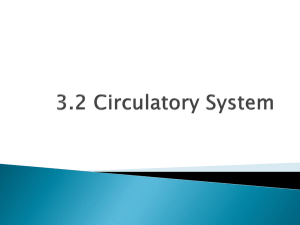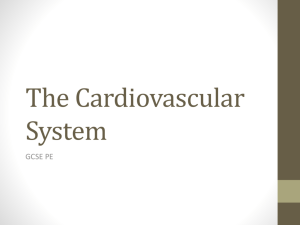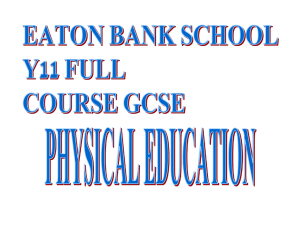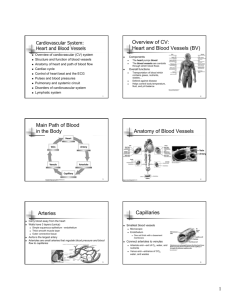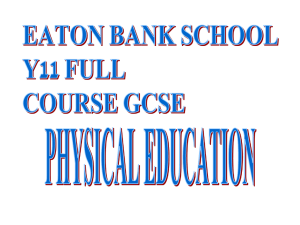GCSE Physical Education
advertisement
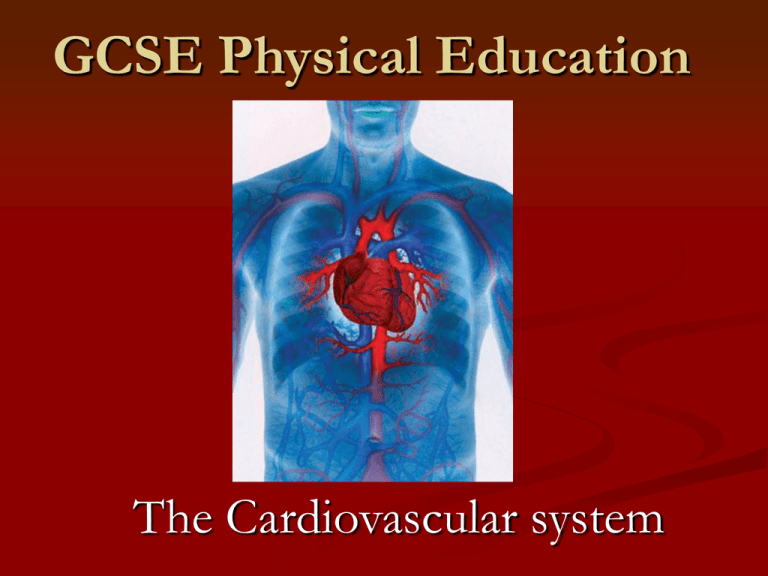
GCSE Physical Education The Cardiovascular system By the end of this topic you should be able to: Describe the Cardiovascular system Explain the immediate effects of exercise, and the long term benefits of regular exercise, on the cardiovascular system. Explain how rest, diet, and drugs affect the cardiovascular system. Cardio-Vascular Fitness ‘The ability to exercise the entire body for long periods of time.’ Cardiac Vascular Of the heart Of or containing vessels for conveying blood. CV fitness has some benefit to all sports performers, indeed to everyone, as it concerns the fitness of the most important muscle in the body – the heart! The Circulatory System The Circulatory system consists of the: Heart Blood vessels Veins/arteries/capillaries etc… Blood Red/White blood cells, platelets, plasma. Pulmonary & Systemic circuits Functions of the Circulatory System Transport Control body temperature Oxygen and nutrients to parts of the body and remove toxic products, such as Carbon dioxide from the body – the body relies on these to keep alive. The balance of the nutrients also keeps the body functioning properly. The body is affected by changes of temperature, so keeping it in an acceptable range keeps the body functioning properly. Protection Antibodies in the blood fight disease and platelets help to clot the blood at the source of a cut and prevent germs entering the body. The Heart The Heart is a muscular pump It is divided into two halves by a central partition called the septum. Each half is then divided by valves into an atrium and a ventricle. The right side of the heart deals with deoxygenated blood; and the left deals with oxygenated blood. The Heart The Heart The Atria & Ventricles The atria are the top two chambers, and the ventricles the bottom two. The Septum The Septum is the strong muscle that divides the heart into two halves, preventing the deoxygenated blood from mixing with the oxygenated blood. It is also the powerful muscle that contracts and pumps the blood. The Heart The Double Circulatory System The human body requires a double body circulatory system, so that it can reoxygenate the blood at the same time as circulating oxygenated blood around the body. Pulmonary Circuit Carries blood from the heart to the lungs and back again. Systemic Circuit Carries blood from the heart to the rest of the body and back again. The Cardiac Cycle Diastole The atria passively fill with blood RA from the superior & inferior vena cava LA from the pulmonary veins Atrial systole The atria contract forcing blood into the ventricles Ventricular systole The ventricles contract forcing blood from the heart RV into the pulmonary artery LV into the aorta What are the immediate effects of exercise on the heart? The heart beats faster and stronger to supply more oxygen to the muscles. This is caused by adrenaline, a hormone released during exercise. Body temperature- muscles generate heat which causes the body temperature to rise. Sweat- To cool down the body produces sweat. ENERGY is needed to make the sweat evaporate and this causes the temperature to fall. Lactic acid- when your muscles demand more oxygen than can be supplied lactic acid builds up causing muscle fatigue. = Blood Pressure Blood pressure is the force exerted by blood on the walls of the arteries. It increases during exercise because more blood is pumped around the body, increasing pressure on the blood vessels. A blood pressure meter is used to measure systolic & diastolic pressure. Blood pressure Systolic BP The maximum pressure in the arteries when the heart contracts & pushes blood through the aorta. Diastolic BP The pressure of the blood during the relaxation phase of the cardiac cycle. It depends mainly on the elasticity of the arteries & quality of the vessels. How can I reduce the risk of high blood pressure? Check your weight Limit your alcohol consumption Don’t smoke! Smoking damages the heart and blood vessels & raises blood pressure. Reduce salt intake Avoid stressful situations that may cause anxiety or worry. Regular exercise Heart rate (HR) Heart Rate The number of times the heart beats per minute (bpm) Can vary considerably from person to person, Average resting HR = 72 bpm Elite athlete e.g Lance Armstrong, Steve Redgrave, Paula Radcliffe can have significantly lower resting HR’s. Max Heart Rate 220 - age Stroke Volume (SV) The volume of blood ejected from the heart in one heart beat. At rest: approx 80ml During exercise: up to 130ml Cardiac Output (Q) The amount of blood ejected from the heart in one minute Cardiac Output = Heart Rate x Stroke Volume Q HR SV Immediate effects of Exercise on the Heart Muscles need oxygen to work. During exercise the demand for Oxygen is increased. Therefore; the cardiac output needs to be increased. This is achieved by an increase in Heart Rate and Strove Volume. With increasing fitness the following occur: The heart pumps more blood every beat. After Before Beats per minute 160 140 100 Recovery rate = 5 mins 60 0 Beats per minute Time (mins) 160 140 Recovery rate = 2 mins 100 60 0 Time (mins) Long term effects of exercise Endurance training, commonly known as aerobic/cardiovascular training, helps strengthen the heart. With training the general size of the heart gets bigger, the walls become thicker and stronger. 20 mins + @ 60-80% of max HR Myocardial hypertrophy. Therefore: The SV increases Resting HR decreases (bradycardia) Can work for longer at higher intensities. The effect of lifestyle on the CV system You will need to be able to explain: The need for rest & recovery time The impact of diet on the CV system, in particular how it can effect blood pressure and cholesterol The effects of recreational drugs Rest Rest is essential for recovery and adaptation. Allows the heart to grow in size and thickness Myocardial hypertrophy Increases the number of capillaries Capillarisation High cholesterol Cholesterol is a fatty substance carried in the blood by lipoproteins. Lipoproteins come in 2 forms: High Density (HDL) Low Density (LDL) HDL contains more protein than fat & is referred to ‘good cholesterol’ because it carries cholesterol away from the arteries to the liver which removes it. LDL consists of mainly fat. It is the major cause of cholesterol in the blood, & it can lead to a build up of plaque which can restrict blood flow in the arteries. Blockages result in an increase in blood pressure Diet Foods rich in HDL include: Fruit, vegetables, whole grains & legumes (peas & beans) High cholesterol can be caused by a diet high in LDL’s, such as saturated fat. Socially Acceptable/ Recreational drugs Substances used on a regular basis by many people. Caffeine, nicotine, ethanol (alcohol) Smoking Nicotine is not a banned drug. Increases risk of CHD by damaging the heart and the Oxygen carrying capability of blood. It also damages blood vessels and raises your blood pressure. Lowers HDL levels & increases the tendency for blood to clot Alcohol Alcohol in moderation is thought to increase HDL & so in the long term can help to lower blood pressure. However, too much alcohol and binge drinking can have serious adverse affects. Sedentary lifestyle Inactivity means that the CV system does not receive the benefits of exercise. Also is a major contributory factor to the rise in obesity. Stress Negative stress build up over time and can affect the CV system by leading to an increase in blood pressure & elevated heart rate.
